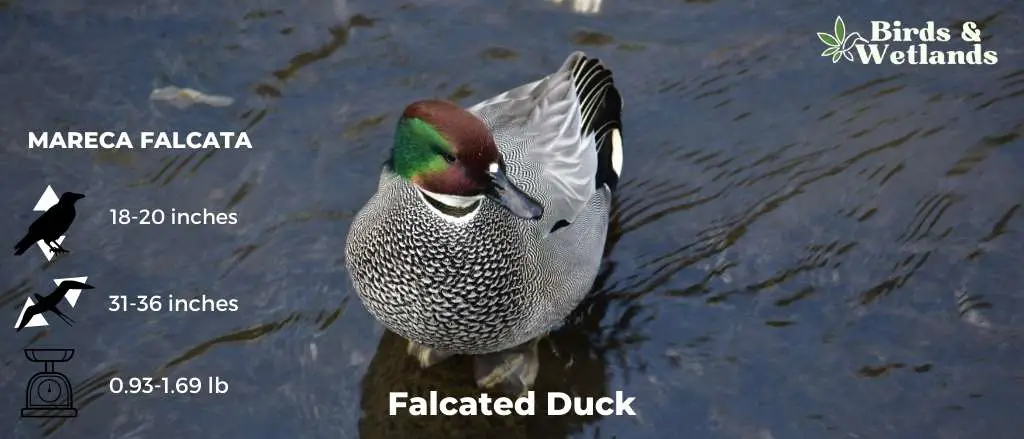The falcated duck (Mareca falcata), also called the falcated teal, is a dabbling duck native to eastern Asia. It breeds in eastern Russia, northern Japan, northeastern China and North Korea. It is a migratory species, with some populations wintering in Southeast Asia and parts of Japan, while others migrate to Korea, Japan, and eastern China.
These ducks eat vegetation and can be seen consuming animals in lowland wetlands.
The common name of the falcated duck likely comes from the sickle-shaped markings on the male duck’s wings, which are shaped like a falx or scythe.
Scientific Name: Mareca falcata
Height: 46 to 53 cm (18–21 in)
Wingspan: 79 to 91 cm (31–36 in)
Weight: 422 to 770 g (14.9–27.2 oz)
Taxonomy
The falcated duck is closely related to the gadwalls and wigeons. These ducks used to be in the same group as other ducks in the genus Anas but were later moved to a different group called the genus Mareca.
Gadwalls and falcated ducks are related but different. It is believed that the two species bred together in the past or are so new as species that their DNA has not had time to become different. These birds shared morphological traits, especially with the pure Eurasian wigeon female.
Additionally, it is possible that hybridization led to the introduction of falcated duck mitochondrial DNA (mtDNA) into the gene pool of the gadwall.
Further research into hybrid avian species may shed light on avian reproduction, evolutionary biology and to explain current genetic diversity.

Physical Description
The falcated duck got its common name after its long curved-like-a-sickle feathers. Males and females have a pale grey underwing which is visible in flight.
Male Duck
The adult male falcated duck in breeding plumage is a beautiful bird with a dark green head, gray body and several distinctive features. Its breast has black crescents, while its mantle and sides have dark vermiculations.
The belly and vent are yellowish-white with a unique black-and-white pattern. It has elongated scapulars, long tertials, glossy green secondaries, and blackish-grey primaries with paler underwings.
Its rump, upper tail coverts, and tail are solid black with a white band and yellowish-white undertail coverts. It has a long crest, iridescent hues, and a white spot on its forehead.
Underneath, it has a white chin, throat, and foreneck with narrow black collars and a slender ebony bill.
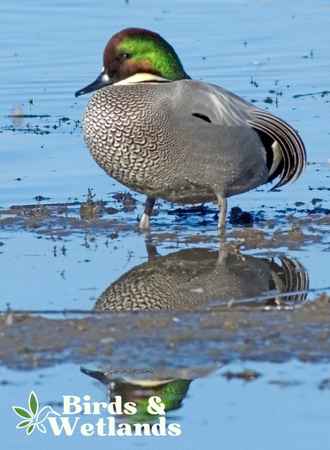
Female Duck
The adult female falcated duck has a warm brown plumage color with dark and heavy patterning. This patterning is formed by numerous dark crescents, creating a cryptic effect and camouflage from potential predators.
The green mirror is duller than usual on the wings, and the tertials are much shorter and straight. There is a shorter crest than normal on the head, and both the head and neck are greyish-brown with narrow, darker streaks. The bill of this female bird is dark grey with blackish spots along its culmen.
The female is paler in overall appearance than her non-breeding male counterpart.
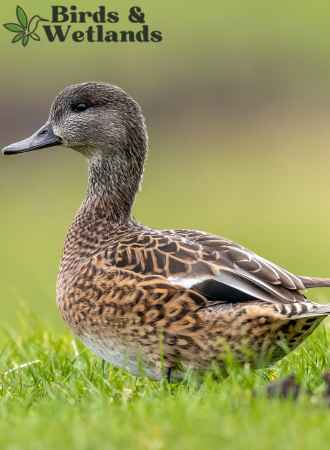
Listen to the Falcated Duck
The falcated duck makes a neck-stretching burp call.

Habitat & Breeding Range
The falcated duck breeds in the Far East, from eastern Siberia and China in the west to Japan, Korea and northern Vietnam in the east.
These migratory birds nest in shallow wetlands, such as lakes, marshes, ponds, and bogs, either seasonally flooded or permanently. They also prefer sparsely vegetated wetlands with plenty of aquatic vegetation for foraging. During the breeding season, they usually inhabit lowland areas below 2000 meters in elevation.
There are migratory shorebirds present in various habitats within its expansive range. While they typically occupy freshwater wetlands like lakes and marshes, they have also utilized brackish coastal wetlands, lagoons and sheltered estuaries when these resources are available.
Sometimes, they nest in agricultural fields or use flooded rice paddies as feeding grounds during the migratory season.
The preferred breeding territory of the falcated duck is characterized by lush vegetation, including aquatic plants like reedgrass, bulrush, and cattail, which protect from predators and nesting material. You can often see falcated ducks roosting in these areas.
In addition to these plants, shallow open water bodies with submerged vegetation are important features of preferred habitat as they provide an abundant source of food items such as plant food, insects, crustaceans, and mollusks for adult birds and their young.
The presence of shallow shoreline margins is also beneficial for ducks seeking safe refuge from predators or inclement weather.
In winter, when resources become scarce within its high-latitude range, this species may migrate southward in search of more favorable conditions in their wintering grounds. Some birds have been seen mixed with Eurasian wigeon flocks.
The estimated global extent of the falcated duck is between 1,000,000 and 10,000,000 km 2. (390,000–3,860,000 sq mi)
This bird is a rare vagrant in western North America. The animals sighted escaped captivity.
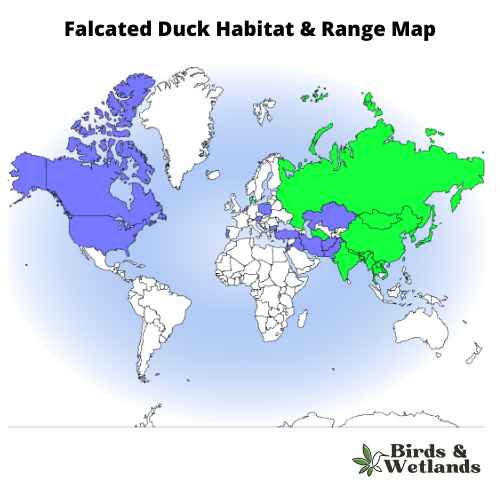
Behavior & Diet
The falcated duck is a species of omnivorous waterfowl that feed on a wide variety of plant and animal matter. The duck has food habits generally consisting of small insects and invertebrates such as larvae, crustaceans, mollusks, and spiders found near water sources.
In addition to these animal food sources, Asian falcated ducks consume various types of vegetation from the marshy wetlands they inhabit, including leaves, seeds, grains, nuts, aquatic plants, and roots.
To find food in their wetland habitats, falcated ducks use their bills to search through mud and shallow waters for prey. They will also sometimes dive beneath the surface to search for food.
Additionally, these birds are known to scavenge for scraps left by fishermen or farmers along the shorelines.
An interesting fact about falcated ducks is that they help to disperse seeds over large areas by consuming vegetation as they move around. This benefits local ecosystems because it promotes vegetation regrowth in and around wetlands and can even lead to new growth in areas where the seed has not been present.
The falcated duck lifespan is currently unknown.

Nesting & Mating Habits
The falcated duck has a fascinating mating and nesting ritual. To attract a mate, the male will perform courtship displays, such as head bobs and extended wings.
Once the pair is formed, they usually move away from other ducks and search for an ideal nesting spot. The nest could be in tall grasses, dense shrubbery, or even in deadwood near the water.
During the mating season, the female species will lay between 6 – 10 white with pinkish-yellow eggs over several days. She will then remain at the nest during incubation for 24-25 days until the eggs hatch, while her mate leaves her to join other males to molt.
After they hatch, the mother cares for the young birds and teaches them how to survive on their own by teaching them to feed and fly. Eventually, the mother will abandon her young, and the abandoned chicks will join other ducklings to form a creche.
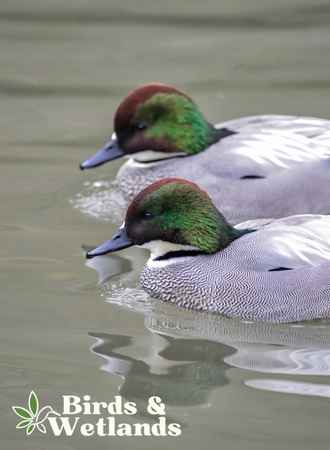
Threats & Conservation
The current population of about 90,000 birds is much higher than the previous population estimate of 35,000.
The falcated duck is a near-threatened species that faces several threats to its survival even though it is no longer part of the IUCN’s endangered species list.
These threats include habitat loss, hunting, significant environmental disturbance and the introduction of invasive species that compete with the duck for resources.
Climate change and agricultural development have had a particularly damaging impact on the duck and other species natural wetlands, which are essential for its breeding and migration.
Hunting has also contributed to a decline in the falcated duck population, as the ducks have limited access to protected areas throughout their range.
Introducing non-native predators, such as dogs and cats, has also had a major impact on the population.
Conservation efforts have focused on protecting wetlands and reintroducing falcated ducks into protected habitats. However, these efforts have been difficult to implement due to the duck’s wide range and complex migration patterns.
There have been some successes in restoring local populations in parts of Asia where hunting pressures are lower than in other areas. However, continued conservation efforts are needed to ensure the long-term survival of this species.
Many conservationists are pushing authorities to continue monitoring populations from already existing nature reserves and most ecologically sensitive areas.
National nature reserves help prevent waterfowl extinction, especially in eastern China’s populations of falcated ducks. Additionally, reclamation projects to create artificial wetlands and acceptable habitat were started in the late 1990’s and completed in mid-2000’s.
There is about twenty-seven percent of the near-threatened falcated duck species existing in natural nature reserves worldwide. Nature reserves provide a safe and protected habitat for falcated duck populations and other globally threatened Anatidae species to thrive, ensuring their continued survival.

Key Points
- The falcated duck is closely related to the gadwall and wigeon. These ducks form the genus Mareca.
- The falcated teal is known for its very intricate courtship ritual.
- These ducks primarily eat small animals and, likewise eat plant foods.

